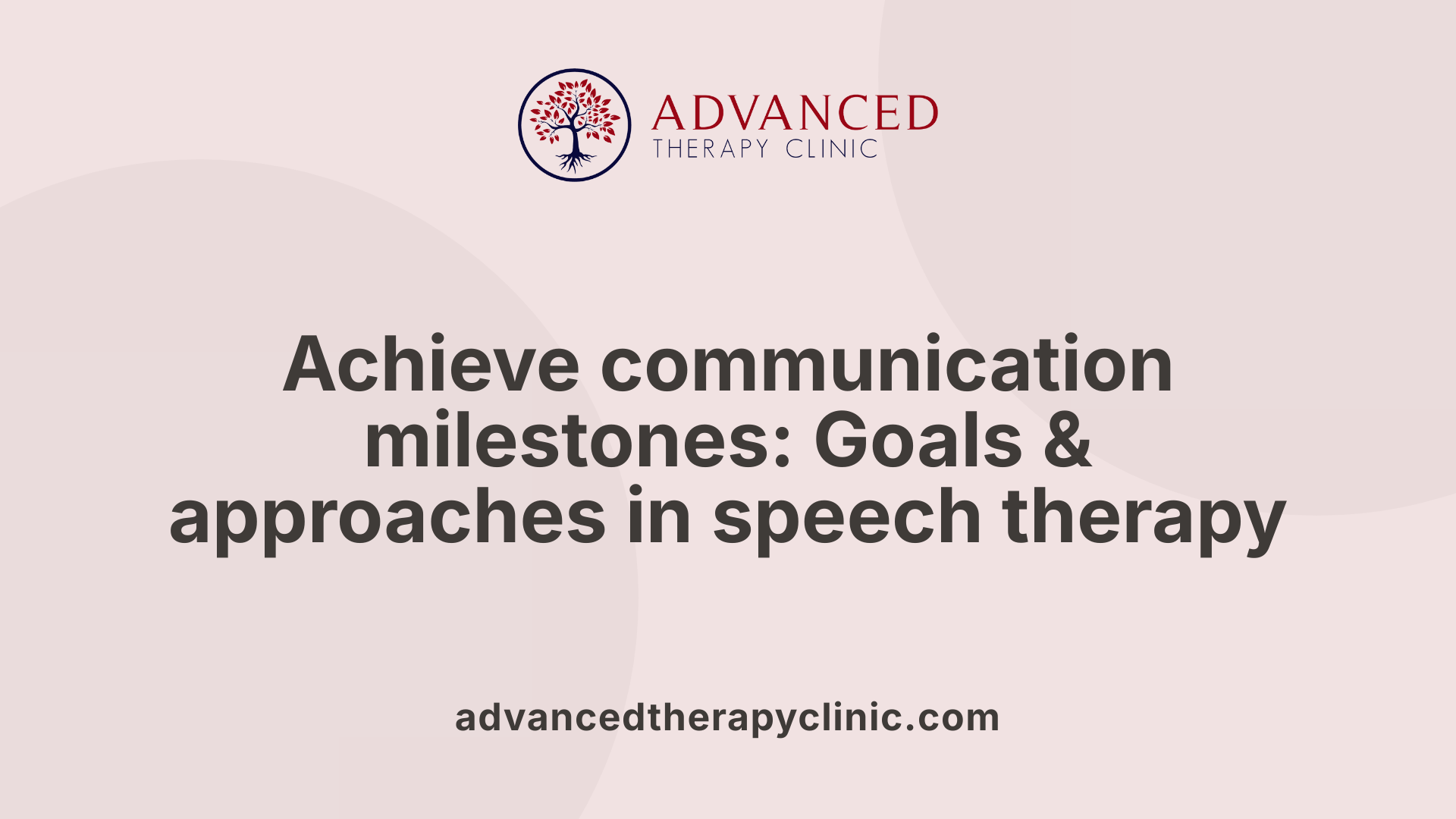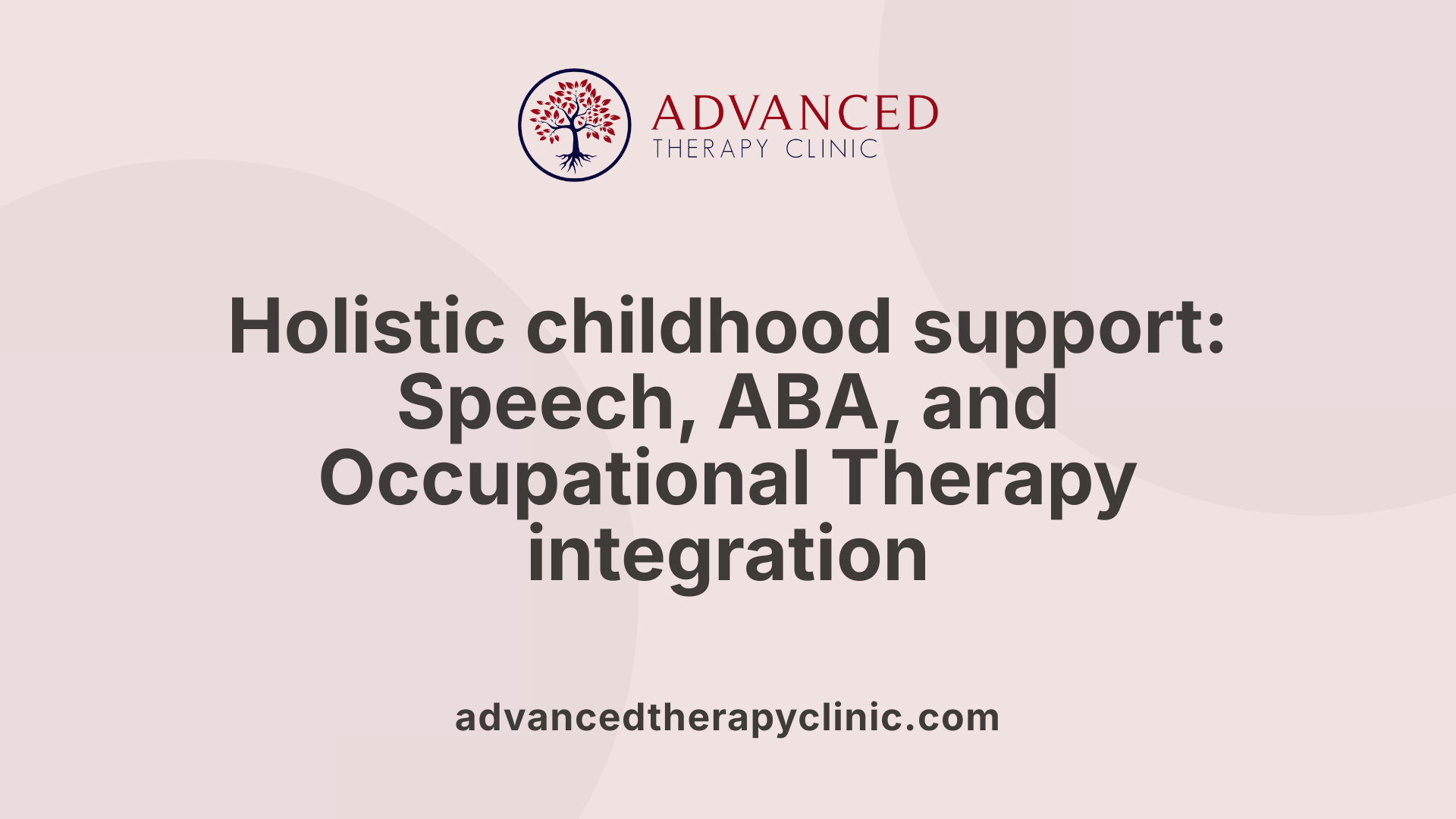Pediatric Speech Therapy Programs


Why Pediatric Speech Therapy Matters
Early diagnosis and intervention for autism spectrum disorder (ASD) are critical for improving communication, social interaction, and cognitive skills in children. Among the variety of therapies available, pediatric speech therapy plays a vital role in helping young children, especially those diagnosed with ASD, develop their language and communication abilities. This article explores how speech therapy integrates with other supportive therapies and highlights its importance within early intervention programs tailored to pediatric needs.
The Importance of Early Intervention in Pediatric Speech Therapy

How Early Can Autism Spectrum Disorder Be Diagnosed?
Autism spectrum disorder (ASD) can sometimes be identified before the age of 2. In some cases, children may exhibit typical development initially but experience regression around this time. Early diagnosis is crucial because it opens the door for timely support.
Why Is Starting Intervention As Early As Six Months Beneficial?
Intervening as soon as autism is diagnosed—even as early as six months—yields the most effective outcomes. Early services engage critical developmental periods when children’s brains exhibit high plasticity, meaning they can adapt and change more readily.
What Role Does Brain Plasticity Play in Therapy?
The brain’s exceptional plasticity during early childhood allows therapies to make lasting improvements. Interventions during this window can significantly boost skills such as communication, social interaction, cognition, and emotional regulation. This early work even increases the chance that a child may not require an autism spectrum classification later on.
What Long-Term Improvements Come From Early Intervention?
Early intervention dramatically enhances communication, social skills, and cognitive abilities. It sets a foundation for physical development as well as thinking and emotional growth. These improvements contribute to greater independence and quality of life over time.
How Does Pediatric Speech Therapy Fit Into This Framework?
Speech therapy is a core part of early intervention, focusing on verbal and nonverbal communication skills. Therapists work with children to improve spoken language, gestures, social communication, and alternative communication methods when needed. Combined with other services, such as occupational and physical therapies, speech therapy helps build well-rounded developmental gains during this critical period.
Targeted Goals and Approaches of Pediatric Speech Therapy Programs

Language and Communication Challenges for Children with Autism
Children with autism often face difficulties in expressing themselves verbally and nonverbally. These communication challenges can affect their ability to socialize and engage effectively with others.
Speech Therapy Goals: Spoken Language, Nonverbal Communication, Alternative Methods
Speech therapy aims to improve a child's spoken language abilities, enhance nonverbal communication such as gestures, and introduce alternative communication methods like using pictures. These goals help children better express their needs and interact socially.
Role of Speech-Language Pathologists (SLPs) in Assessment and Treatment
Speech-language pathologists (SLPs) are trained professionals who diagnose communication disorders and develop personalized treatment plans. They work with children to improve articulation, comprehension, and social communication skills.
Improvement of Verbal and Nonverbal Communication Skills
Therapy sessions focus on strengthening verbal skills such as pronunciation and sentence structure while also addressing nonverbal cues including eye contact, gestures, and facial expressions to foster meaningful interactions.
Use of Pictures and Gestures as Alternative Communication
For some children, using pictures or sign language serves as an effective alternative to verbal speech. These methods support communication development and help children convey messages even before their spoken language matures.
Integrating Speech Therapy with Other Early Intervention Therapies
How do speech therapy, occupational therapy, and ABA collaborate in autism intervention?
Early intervention for children with autism often involves integrating multiple therapies to provide comprehensive support. Speech therapy, occupational therapy (OT), and Applied Behavior Analysis (ABA) each focus on different yet complementary areas of development.
Speech therapy primarily addresses communication challenges, enhancing verbal and nonverbal skills. Occupational therapy focuses on daily life skills, fine motor development, sensory processing, and coordination. ABA offers an intensive, data-driven approach targeting social skills, cognitive abilities, behavior, and communication through behavior-based principles.
What holistic approaches combine communication and motor skills?
By combining these therapies, children benefit from a holistic developmental plan. Speech and OT support both communication and physical or sensory challenges, while ABA reinforces these skills with structured learning and positive reinforcement. This comprehensive strategy targets the whole child, fostering progress across social, emotional, cognitive, and motor domains.
How are treatment plans personalized for each child?
Treatment plans are customized to each child’s unique needs. Collaborative teamwork among therapists ensures that interventions overlap where beneficial—for example, OT and speech therapy can coordinate sessions to work on fine motor skills that support communication, such as using gestures or assistive devices. Meanwhile, ABA guides the intensity and focus of sessions based on ongoing data collection.
What specific roles does occupational therapy play?
Occupational therapists enhance participation in daily routines by improving fine motor skills, sensory processing, and coordination. They help children develop independence in everyday activities, which can interconnect with improved communication and social interaction gained through other therapies.
What distinguishes ABA's methodology and goals?
ABA therapy is notable for its intensity and data-driven nature, often involving up to 30 hours weekly, far more than typical speech therapy sessions. It targets a broad range of skills including social interaction, communication, daily living tasks, and behavior modification, applying behavioral science principles such as positive reinforcement to promote meaningful skill development.
This integrated approach not only supports foundational communication and motor skills but also encourages independence and self-sufficiency, maximizing the benefits of early intervention for children with autism.
How Speech Therapy Complements ABA and Occupational Therapy

What are the differences between speech therapy and ABA therapy?
Speech therapy and Applied Behavior Analysis (ABA) therapy serve different but complementary roles in autism intervention. Speech therapy primarily focuses on improving verbal and nonverbal communication, including spoken language, gestures, and alternative communication methods like picture systems. Sessions typically last 30 to 45 minutes, a few times per week.
ABA therapy, on the other hand, is a research-backed, data-driven approach centered on behavior modification and skill acquisition. It targets social skills, communication, daily living, play, and cognitive and motor skills through intensive sessions that can total up to 30 hours a week. ABA employs learning principles like positive reinforcement to encourage effective behaviors.
How does ABA therapy focus on behavior modification and skill acquisition?
ABA therapy teaches children the function and purpose of language and behavior, aiming to enhance not just communication but also social interaction and safety skills. It uses structured, individualized programs designed to promote meaningful behavior changes and overall developmental progress tailored to each child’s needs.
What is speech therapy's role in language and social communication development?
Speech therapy addresses core communication challenges faced by children with autism, aiding improvements in articulation, language comprehension, and social communication abilities. It strengthens both verbal skills and nonverbal skills such as gesturing, crucial for effective interaction in daily life.
How does occupational therapy enhance fine motor and sensory skills linked to communication?
Occupational therapy supports the development of fine motor skills, sensory processing, and coordination, all essential for everyday tasks and effective communication. OTs focus on real-life routines, promoting independence by integrating physical, cognitive, and play skills that complement speech and behavior interventions.
What are the benefits of combining these therapies for comprehensive developmental support?
Integrating speech therapy, ABA, and occupational therapy offers a holistic approach. Collaboration among therapists leads to personalized treatment plans that address communication, behavior, motor skills, and sensory processing together. This synergy enhances skill generalization across settings, fostering greater independence, social interaction, and overall developmental gains for children with autism.
Enhancing Independence Through Pediatric Speech Therapy Programs

Building Communication Skills to Support Independence and Self-Sufficiency
Speech therapy plays a vital role in helping children with autism develop essential communication skills. These programs target both verbal and nonverbal communication, teaching children to express needs, understand others, and engage socially. Effective communication is foundational for self-sufficiency and encourages independence in various aspects of life.
Speech Therapy's Role in Improving Social Communication and Daily Living Skills
By focusing on social communication abilities, speech therapy enhances a child's capacity to participate in conversations, interpret social cues, and build relationships. Additionally, improving daily living skills through communication supports children in managing self-care tasks and interacting effectively in their environments.
Importance of Integrating Physical, Motor, and Communication Training
Combining speech therapy with occupational and physical therapies creates a holistic approach that addresses multiple developmental areas simultaneously. Physical and motor skills training enhances coordination and mobility, while speech therapy ensures children can communicate their needs and emotions effectively, promoting greater independence.
Impact on Participation in Daily Routines and Social Environments
Integrated therapy programs encourage children to engage more fully in daily routines at home, school, and social settings. Improved communication and motor skills allow children to participate actively, fostering confidence and reducing dependency on caregivers.
Long-Term Outcomes for Children Benefiting from Comprehensive Therapy Programs
Children who receive early and comprehensive therapy, including speech, occupational, and physical therapy, often experience significant improvements in communication, social interaction, and motor abilities. These gains support better overall functioning and increase the likelihood of achieving greater independence and quality of life as they grow.
The Transformative Impact of Pediatric Speech Therapy
Pediatric speech therapy programs are a cornerstone of early intervention for children on the autism spectrum and those facing communication challenges. By addressing both verbal and nonverbal communication needs and integrating closely with occupational therapy and Applied Behavior Analysis, these programs foster holistic development, nurture independence, and enhance quality of life. Early engagement in speech therapy harnesses the brain's plasticity during critical developmental windows, providing children with the tools they need to thrive socially, cognitively, and emotionally as they grow.
References
Recent articles

What Is ABA Therapy?
Unlocking the Power of Behavior Science in Autism Support

High-Functioning Autism
Understanding the Spectrum: Navigating High-Functioning Autism

How Speech Therapy Enhances Listening and Comprehension Skills
Unlocking Communication: The Power of Speech Therapy in Listening and Comprehension Development

What Is Autism Scripting?
Understanding the Role of Repetitive Speech in Autism

Is Speech Therapy Covered By Insurance
Understanding Insurance Coverage for Speech Therapy: What You Need to Know

The Role of Physical Therapy in Post-Surgery Recovery
Enhancing Post-Surgical Outcomes with Targeted Rehabilitation


